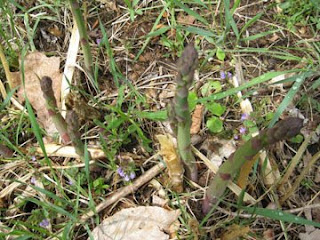Rhubarb is in full swing in my corner of Western Massachusetts right now, pushing up outrageously large leaves to protect its red and green stalks. I love living in Rhubarb Country.
Areas like mine with a relatively cool climate are ideal for rhubarb, which must have temperatures below 40 degrees Fahrenheit in order to grow. It is cultivated extensively in the northern United States, in Canada, and in Europe and England. Rhubarb plants are hardy and don’t need a lot of care. (This is a major reason for my own love of rhubarb.)
Obviously, we’re not the only people enjoying rhubarb right now. A quick internet search lately yielded word of rhubarb festivals in a variety of places. I wish I could go to every single one of them. Instead, I’m mentioning just a few here—just in case readers feel like a spot of travel.
In Yorkshire, England, in what is known as the “Rhubarb Triangle,” rhubarb became a popular winter crop beginning in the 1880s. It was cultivated outdoors and moved in the fall into indoor rhubarb sheds, where it was forced and harvested by candlelight in February.
The rhubarb sheds are disappearing from the Yorkshire landscape just as my Pioneer Valley is losing its historic tobacco barns. Nevertheless, the dwindling tradition of the candlelight rhubarb harvest is still treasured by the remaining growers and rhubarb lovers in the area.
They organize an annual rhubarb celebration in February. This year’s festivities included a rhubarb lassi drink from a local Indian chef. (I’d love to have that recipe!) The festival also included tastings of rhubarb cheese made by a local cheesemaker (and monger), Cryer & Stott.
Lanesboro, Minnesota, calls itself the Rhubarb Capital of that state. Its annual Rhubarb Festival is scheduled this year for June 10. It features rhubarb games known as the Rhubarb Olympics, including rhubarb golf, in which participants use a stalk of rhubarb to propel balls into the air. Naturally, it also sponsors a cooking contest, as well as a Rhubarb Rant Speakers Corner for people who love to spout off about this controversial plant.
Kitchen Kettle Village in Intercourse, Pennsylvania, has just concluded its annual Rhubarb Fest, which included a dance called the Rhubarb Stroll and an automotive Rhubarb Derby.
Aledo, Illinois, will hold its Rhubarb Festival on June 5 and 6. This event features sales by local businesses, a whole lot of rhubarb pie, and a contest to see who can grow the largest rhubarb leaf.
Conrad, Montana, will celebrate its Rhubarb Festival on June 13 and 14. This shindig will be combined with something called “Whoop-Up Days,” which include a car show and a rodeo.
Finally, L&S Gardens, a nursery in La Pine, Oregon, will sponsor a Rhubarb Festival this weekend on May 30. L&S’s Linda Stephenson sprinkles vendors all over her nursery. Visitors can also find live music and of course rhubarb—much of it prepared in various forms by the local Dutch Oven Cooking Club, of which Linda is president.
She and her husband Sonny became interested in cooking in outdoor cast-iron Dutch ovens after reading about Sonny’s great-grandmother’s cooking methods in an old family diary.
The nursery also sells fresh rhubarb and rhubarb plants that day as well as a small cookbook Linda has written, appropriately titled Rhubarb Country. She lures customers with samples of her favorite rhubarb salsa, which can be served on chips or on crackers spread with cream cheese.
Linda was nice enough to share her recipe with me so I’m passing it along to you, along with a few other formulas that show off this versatile spring plant. Perhaps it will inspire another festival or two next rhubarb season—even in my own area!

L&S Rhubarb Salsa
I know readers are probably thinking that both Linda Stephenson and I are taking our passion for rhubarb a stalk too far with the concept of rhubarb salsa. I must write in our defense that this salsa is AMAZING, my favorite combination of sweet and spicy so far this year. I served some to my friend and neighbor Will Cosby, who is emphatically not a rhubarb fan. He devoured it.
So please reserve judgment and try it. (You may halve the recipe if you feel timid.)
One caveat: the salsa is a little wet. Next time I make it I’ll probably try omitting the water (I’ll mix the rhubarb, orange peel, and sugar in the saucepan and let them sit overnight; the rhubarb and sugar will combine to form juice). This will cut down on the water but not get rid of it altogether. One can always drain the salsa before serving it, however. Or serve it with lots of cocktail napkins!
By the way, Linda’s original recipe called for adding the ginger with the raw ingredients at the end. I decided I’d like it to blend a little more with the rhubarb so I popped it in halfway through the cooking process.
Ingredients:
1 cup granulated sugar
1/2 cup water
2 tablespoons finely shredded orange peel
6 cups rhubarb, chopped 1/2 inch thick
1 teaspoon grated fresh ginger
1/2 cup diced green bell pepper (yellow would do well, too)
1/4 cup finely chopped sweet onion (I used Vidalia)
1/3 cup fine chopped red onion
1 jalapeno pepper, seeded and minced
2 tablespoons honey
2 tablespoons lemon juice
Instructions:
In a non-reactive saucepan combine the sugar, water, and orange peel. Bring the mixture to a boil over fairly high heat.
Add the chopped rhubarb, and reduce the heat to medium. Simmer gently until the rhubarb is tender (about 10 minutes). After the first 5 minutes of simmering, stir in the ginger.
Remove the rhubarb mixture from the heat and allow it to cool to room temperature. When it is cool add the remaining ingredients. Mix well. You may serve this salsa chilled or at room temperature. As I noted above, it is tasty with tortilla chips or on crackers with cream cheese; it would also blend well with chicken, pork, or fish.
Makes 4 cups of salsa, more or less (depending on the juiciness of your rhubarb).
I know readers are probably thinking that both Linda Stephenson and I are taking our passion for rhubarb a stalk too far with the concept of rhubarb salsa. I must write in our defense that this salsa is AMAZING, my favorite combination of sweet and spicy so far this year. I served some to my friend and neighbor Will Cosby, who is emphatically not a rhubarb fan. He devoured it.
So please reserve judgment and try it. (You may halve the recipe if you feel timid.)
One caveat: the salsa is a little wet. Next time I make it I’ll probably try omitting the water (I’ll mix the rhubarb, orange peel, and sugar in the saucepan and let them sit overnight; the rhubarb and sugar will combine to form juice). This will cut down on the water but not get rid of it altogether. One can always drain the salsa before serving it, however. Or serve it with lots of cocktail napkins!
By the way, Linda’s original recipe called for adding the ginger with the raw ingredients at the end. I decided I’d like it to blend a little more with the rhubarb so I popped it in halfway through the cooking process.
Ingredients:
1 cup granulated sugar
1/2 cup water
2 tablespoons finely shredded orange peel
6 cups rhubarb, chopped 1/2 inch thick
1 teaspoon grated fresh ginger
1/2 cup diced green bell pepper (yellow would do well, too)
1/4 cup finely chopped sweet onion (I used Vidalia)
1/3 cup fine chopped red onion
1 jalapeno pepper, seeded and minced
2 tablespoons honey
2 tablespoons lemon juice
Instructions:
In a non-reactive saucepan combine the sugar, water, and orange peel. Bring the mixture to a boil over fairly high heat.
Add the chopped rhubarb, and reduce the heat to medium. Simmer gently until the rhubarb is tender (about 10 minutes). After the first 5 minutes of simmering, stir in the ginger.
Remove the rhubarb mixture from the heat and allow it to cool to room temperature. When it is cool add the remaining ingredients. Mix well. You may serve this salsa chilled or at room temperature. As I noted above, it is tasty with tortilla chips or on crackers with cream cheese; it would also blend well with chicken, pork, or fish.
Makes 4 cups of salsa, more or less (depending on the juiciness of your rhubarb).



































